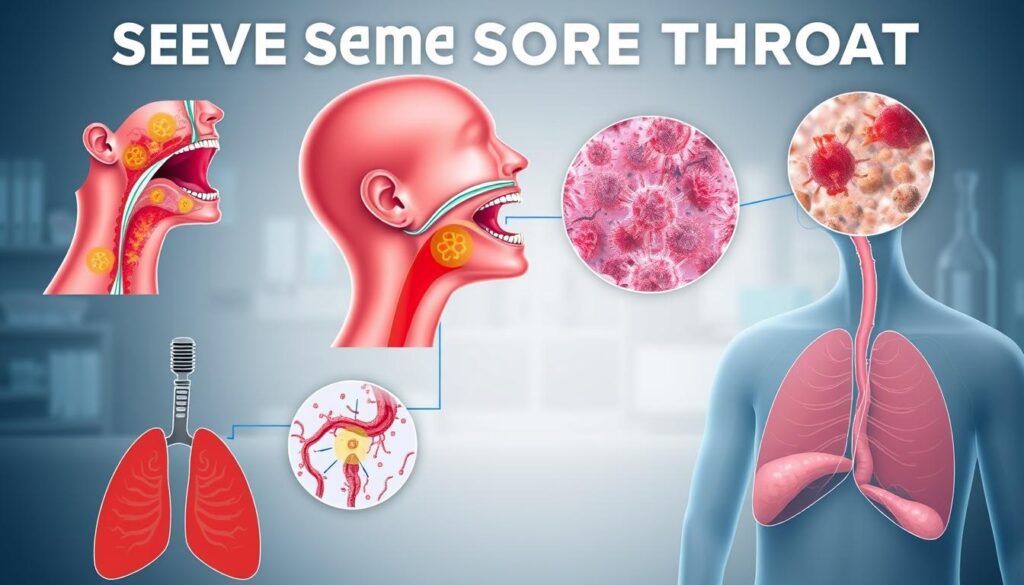A shocking 37% of recent U.S. respiratory infections stem from a single new strain causing what patients call “the worst throat pain of their lives.” Health experts are tracking NB.1.8.1, nicknamed “Nimbus,” which now drives over one-third of cases nationwide. This fast-spreading variant brings a unique symptom that’s grabbing headlines and raising questions.
The CDC reports Nimbus became dominant in early June, outpacing other strains. Unlike earlier versions, it often starts with intense discomfort when swallowing. Some describe it as sharp and persistent, though symptoms vary by person. Doctors emphasize this doesn’t mean all infections will be severe, but it’s wise to stay informed.
Medical teams nationwide are sharing insights about this development. Researchers confirm current vaccines still provide protection against serious illness, but booster updates are under review. Testing remains crucial since early detection helps manage symptoms faster.
You’ll find clear answers here about how Nimbus spreads, why its effects differ, and practical steps to stay safe. We’ve gathered the latest guidance from epidemiologists and primary care physicians to cut through the noise.
Key Takeaways
- Nimbus accounts for 37% of recent U.S. cases per CDC data
- Distinctive throat discomfort is a common early sign
- Rapid spread mirrors patterns seen in previous waves
- Existing vaccines reduce severe outcomes
- Antiviral treatments work best when started early
- Health officials urge updated boosters for high-risk groups
Understanding the Emergence of Nimbus (NB.1.8.1)
Health experts are tracking a strain that’s rewriting the rules of viral spread. Let’s unpack how this new COVID-19 iteration became a global concern almost overnight.
Origins and Global Spread
The story begins in January when scientists in Wuhan identified an unusual pattern in test results. By March, NB.1.8.1 had hopped continents, appearing in 22 nations. A WHO spokesperson noted:
“This strain’s growth rate mirrors early Omicron patterns – doubling every 12 days in some regions.”
Here’s what global tracking reveals:
| Region | First Detection | Current Share |
|---|---|---|
| Asia | January 15 | 41% |
| Europe | March 2 | 28% |
| North America | March 28 | 37% |
Detection and Prevalence in the United States
Airport screenings told the first chapter of America’s story. Travelers arriving in four states between March 20-April 5 carried the earliest U.S. samples. By June’s first week, the Centers for Disease Control and Prevention reported:
- 15% → 37% national case share in 14 days
- Equal dominance with former top strain LP.8.1
This swift rise explains why health networks are enhancing testing protocols. While vaccines still work against severe outcomes, the speed of spread demands attention.
What is the Razor Blade Throat COVID Variant?
Many people are experiencing a new level of discomfort that’s rewriting expectations for respiratory infections. This strain’s hallmark feature has become a talking point in clinics and online forums alike.
Defining the Distinctive Sensation
Those affected report a sharp, cutting pain when swallowing – often compared to passing rough objects through their esophagus. One patient shared:
“It felt like someone poured sandpaper down my neck every time I tried to drink water.”
Medical professionals note this differs from typical soreness in three key ways:
- Sudden onset within 12-24 hours
- Localized burning sensation above the collarbone
- Persistent discomfort even at rest
Contrasting With Earlier Viral Patterns
Previous infections often started with nasal congestion or body aches. Now, many cases begin with this intense throat irritation that overshadows other symptoms. While older strains sometimes caused mild scratchiness, the current version attacks throat tissues more aggressively.
Researchers believe this change stems from alterations in how the virus binds to cells. The result? A unique inflammatory response that standard lozenges and teas can’t easily soothe. Recognizing this pattern early helps people seek appropriate care faster.
Symptoms and Clinical Perspectives of Sore Throat
When respiratory infections strike, your body sends clear signals. Medical professionals are noticing distinct patterns that help identify specific strains through their effects on your system.
Comparative Symptom Analysis
This strain stands out through its uniquely intense discomfort. Let’s examine how it differs:
- Early versions: 73% reported fever first (2021 data)
- Current cases: 68% list soreness as initial symptom
- Previous strains: Mild scratchiness lasting 2-3 days
- Current experience: Burning sensation persisting 5+ days
Dr. Marc Siegel observes:
“The quality of discomfort helps us differentiate between seasonal illnesses and emerging strains.”
Expert Insights on Throat Pain and Discomfort
Emergency physician Kenneth Perry explains why this matters: “When swallowing feels like shards of glass, it changes how patients manage hydration and medication.”
Three key factors drive this extreme sensation:
- Direct viral attack on throat tissue cells
- Increased inflammatory response markers
- Nerve ending sensitivity spikes
While cough and fatigue remain common, the debilitating soreness becomes the primary concern for many. Recognizing this pattern early helps you seek targeted relief faster.
Other Potential Causes Behind Severe Sore Throat
When swallowing feels like sandpaper, your mind might jump to recent headlines. But intense discomfort doesn’t always signal the latest respiratory threat. Many conditions share this symptom, each needing distinct care.

Bacterial Infections and Other Viral Conditions
Strep throat remains a common bacterial culprit. Dr. Linda Tan explains: “White patches on tonsils or sudden high fever often point to streptococcus rather than viral origins.” These infections typically require antibiotics to prevent complications.
Consider these key differences between common causes:
| Symptoms | Bacterial | Viral |
|---|---|---|
| Fever pattern | Sudden high spike | Gradual increase |
| Throat appearance | White patches | General redness |
| Associated signs | Swollen nodes | Cough/runny nose |
Allergies and acid reflux also mimic severe discomfort. Pollen season might leave you with postnasal drip irritation, while stomach acids can burn delicate tissues. Over-the-counter antihistamines or antacids often help.
Dr. Perry emphasizes:
“Only 1 in 5 cases involve bacteria. Testing helps avoid unnecessary antibiotics while ensuring proper treatment.”
If pain persists beyond three days or comes with breathing difficulties, seek professional evaluation. Quick tests can identify strep in minutes, guiding your path to relief.
Preventative Measures and Treatment Options
Managing symptoms while protecting others requires smart strategies. Health experts suggest combining self-care with medical guidance for optimal recovery.
Home Remedies and Over-the-Counter Help
Start with nature’s sweet solution. Dr. Linda Tan notes: “Honey coats irritated tissues while fighting microbes – ideal for sharp discomfort.” Mix it with warm tea or take it straight for quick relief.
Try this simple saltwater recipe from the Cleveland Clinic:
“½ teaspoon salt dissolved in 1 cup warm water reduces swelling better than most store-bought rinses.”
For persistent pain, reach for NSAIDs like ibuprofen. These medications tackle both inflammation and discomfort. Pair them with numbing lozenges or sprays for temporary numbness during swallowing.
When to Seek Professional Medical Guidance
Watch for warning signs that demand expert attention. Emergency physician Kenneth Perry warns: “If swallowing feels like passing shards, dehydration becomes a real risk.”
Use this quick reference table to decide your next steps:
| Situation | Home Care | Medical Care |
|---|---|---|
| Mild discomfort | Honey, salt rinses | – |
| Glass-like sensation | NSAIDs + hydration | If lasting >48hrs |
| Breathing issues | – | Immediate visit |
Health officials emphasize early intervention. When basic measures fail or symptoms intensify, professionals can prescribe targeted therapies. Stay alert – your body’s signals matter.
Public Health Implications and Vaccine Considerations
Staying ahead of respiratory threats requires teamwork between you and health leaders. Recent decisions about prevention strategies are sparking important conversations nationwide.
Insights From Leading Health Organizations
The World Health Organization confirms existing shots work against the new COVID-19 variant. “Current vaccines reduce severe outcomes,” states their latest bulletin. Meanwhile, the CDC tracks how different strains spread through communities.
Some changes surprise medical professionals. Health officials recently adjusted guidelines for certain groups, though many experts disagree with these updates. Always check with your doctor about what’s right for your situation.
Navigating Vaccine Updates
Fall boosters will target older strains, but still help fight newer ones. The FDA plans limited access for these updated shots – primarily for seniors and vulnerable groups. This decision leaves some wondering how to stay protected.
Here’s what matters most: If you’re at higher risk, don’t wait. Health experts urge getting current vaccines if you haven’t in recent months. Pharmacy availability may change as cooler weather approaches, so plan ahead.
While debates continue about recommendations, your best move remains clear. Talk to healthcare providers about personalized protection strategies. Staying informed helps you make smart choices for your well-being.

